WOH G64 is a yellow hypergiant star located at a distance of 160,000 light years from Earth in the constellation Dorado.
The supergiant star is part of a symbiotic binary system. It does not lie in the Milky Way galaxy, but in one of its satellites, the Large Magellanic Cloud (LMC). With an apparent visual magnitude of 17.7 – 18.8, the star is invisible to the unaided eye and cannot be seen in amateur telescopes.
In 2024, WOH G64 became the first star outside our galaxy to be captured in a zoomed-in image by ESO’s Very Large Telescope Interferometer (VLTI). The hypergiant star is believed to be in the final phase of its life and may go out as a supernova within the next millennium.
Star system
WOH G64 is a symbiotic binary star composed of an evolutionary yellow hypergiant and a hot, blue B-type companion. Symbiotic binary stars typically contain an evolved giant star that loses material through a strong stellar wind and a hot compact star that accretes the expelled material through an accretion disk.
The WOH G64 star system is surrounded by a thick envelope of dust about a light year across. The envelope consists of material expelled from the star. WOH G64 has so far expelled between 3 and 9 solar masses of material – between a tenth and a third of its initial mass – through a stellar wind.
The primary component, WOH G64 A, has a radius about 800 times that of the Sun. With an initial mass of around 28 solar masses, the evolved star is a supernova candidate.
The companion was once reported to be a main sequence star of the spectral type O, with a luminosity about 100,000 times that of the Sun. However, the dust that obscures the star makes it a difficult object to study.
The primary star was previously given the stellar classification M7.5(I)e, indicating a red supergiant or hypergiant. The estimates of the star’s surface temperature were in the range between 3,200 and 3,400 K. In terms of evolutionary stage, it was classified as an OH/IR red supergiant.
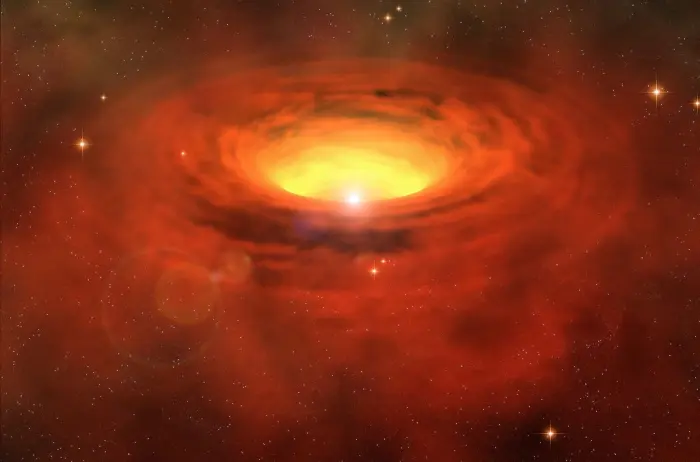
The star WOH G64. An artist’s impression is provided of the thick, massive torus of matter surrounding the star as inferred from observations made with ESO’s Very Large Telescope Interferometer. Image credit: European Southern Observatory (CC BY 4.0)
However, more recent studies suggest an effective temperature of 4,700 K, which would change the star’s spectral type. The higher temperature indicates that WOH G64 has evolved quickly and became a yellow hypergiant.
Astronomers found an average mass loss rate of 3.1 to 5.8 × 10−4 M☉ for the primary star, which was one of the highest known for a red supergiant.
The estimated distance of 160,000 light years or 50,000 parsecs is based on the star’s membership in the Large Magellanic Cloud. This led astronomers to believe that WOH G64 was likely the largest, coolest and the most luminous red supergiant in the galaxy.
A study published in 2009 determined a radial velocity of 294 ± 2 km s–1 for the star, the same as that of the rotating gas in the disk of the LMC. This confirmed the star’s membership in the galaxy, even though WOH G64 showed a number of characteristics that set it apart from other red supergiants in the LMC.
These include the late spectral type, the thick torus-shaped dust cloud, nebular emission lines, and maser activity. The nebular emission lines have an unusual spectrum and indicate the presence of hot gas that is rich in nitrogen and has a radial velocity that is significantly more positive than the star’s.
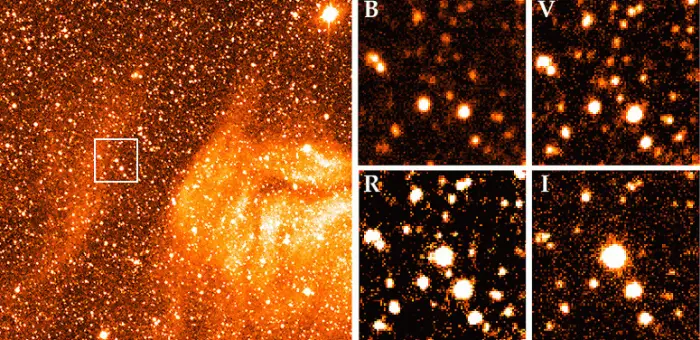
These photos show the location of the very large (“monster”) star, IRAS 04553-6825, in the Large Magellanic Cloud (LMC), a satellite galaxy to our Milky Way, some 160,000 light-years away. The first extragalactic silicon-oxide (SiO) maser was discovered in the atmosphere of this star by means of a very sensitive receiver at the SEST submillimetre telescope at the ESO La Silla Observatory. The upper photo is reproduced from a CCD frame that was obtained in January 1996 with the 3.5-metre New Technology Telescope (NTT) and the EMMI Multi-mode instrument. It is a 20-min H-alpha exposure which shows the large, interstellar clouds in this region of the LMC. IRAS 04553-6825 is situated at the centre of the square box, at the edge of the cloud, from which it was formed by contraction at an earlier epoch. Credit: ESO (CC BY 4.0)
WOH G64 was long classified as a variable star, but its exact type was uncertain. The star’s visual brightness was reported to fluctuate by more than a magnitude with a primary period of about 800 days.
However, at visual wavelengths, the star system is hidden by more than 6 magnitudes of interstellar extinction, and the variation in brightness is considerably smaller in the infrared part of the spectrum.
WOH G64 has been characterized as a carbon-rich Mira variable or long-period variable. Mira variables are pulsating variable red giant stars on the asymptotic giant branch (AGB) with periods of more than 100 days.
A 2024 study revealed that the star’s variability has undergone a significant change from semi-regular to irregular in 2014 and that the supergiant shows properties of a B[e] star. The researchers discovered WOH G64 to be a massive symbiotic system composed of a red supergiant that transitioned to a yellow hypergiant and a B-type companion.
The drastic change may be explained by the interaction between the two stars stripping the envelope, the return to a quiescent state, or the behemoth star expelling its outer layers of gas in the pre-supernova stage.
WOH G64 was subsequently classified as a slow irregular variable and symbiotic binary.
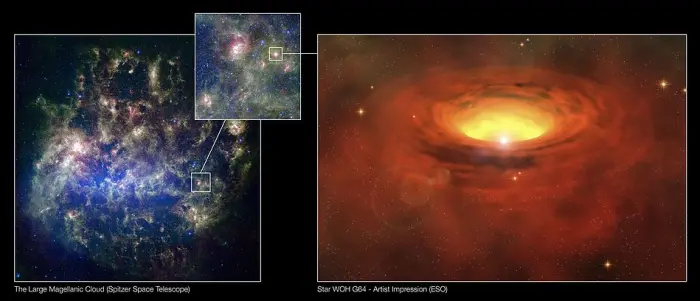
WOH G64, image: European Southern Observatory (CC BY 4.0)
Size
WOH G64 has an estimated radius 800 times that of the Sun. The value of 800 solar radii comes from a 2024 study led by G. Muñoz-Sanchez of the Institute for Astronomy, Astrophysics, Space Applications and Remote Sensing (IAASARS), National Observatory of Athens (NOA), Greece. It is consistent with an initial mass of 28 solar masses instead of 25 solar masses (derived by Ohnaka et al. in 2008) and a temperature of 4,700 K.
With a radius of 800 R☉, WOH G64 would extend past the orbit of Mars and come closer to the orbit of Jupiter if it replaced the Sun at the centre of our solar system.
Previous observations of WOH G64 resulted in radius estimates in the range between 1,540 and 2,575 solar radii, or between 7.16 and 11.97 astronomical units. This would make the supergiant one of the largest stars known, possibly even the single largest star known. With this radius, the star would extend well beyond the orbit of Jupiter, possibly even Saturn.
The star’s radius is largely uncertain and different studies have given different values. Observations with the Very Large Telescope (VLT) in 2007 yielded a bolometric luminosity of 282,000 solar luminosities, an initial mass about 25 times that of the Sun, and a radius 1,730 times solar with an effective temperature of 3,200 K.
A 2009 study gave an effective temperature of 3,400 ± 25 K and a radius 1,540 times that of the Sun. Another study gave an estimated radius of 1,970 to 1,990 solar radii based on a temperature of 3,372 K to 3,400 K and a luminosity of about 450,000 solar luminosities.
The previously estimated radius and other properties of WOH G64 were consistent with those of the largest red supergiants in the Milky Way, including VY Canis Majoris, Mu Cephei and NML Cygni, as well as with theoretical modelling of the most luminous, coolest and largest possible supergiant stars.
The currently accepted value of 800 R☉ still makes WOH G64 larger than the yellow hypergiant Rho Cassiopeiae and red supergiants like Antares and Betelgeuse. However, it places the hypergiant well below the size of the largest stars known, including UY Scuti (909 R☉), RSGC1-F01 (1,530 R☉), VY CMa (1,420 R☉), AH Scorpii (1,411 R☉), VX Sagittarii (1,360 ), Stephenson 2-18 (2,150 R☉), and NML Cygni (1,350 R☉).
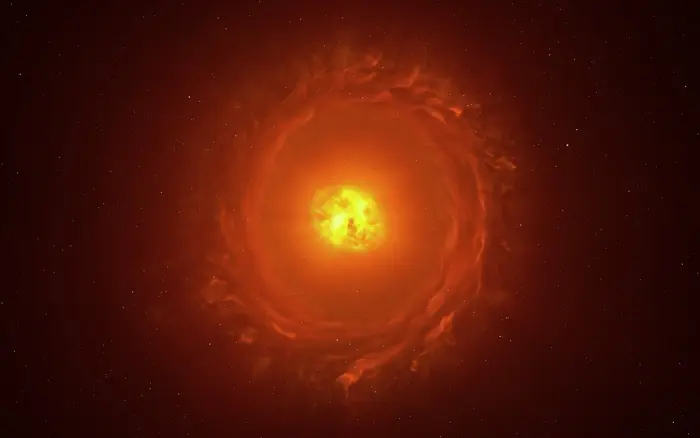
This image shows an artist’s reconstruction of the star WOH G64, the first star outside our galaxy to be imaged in close-up. It is located at a staggering distance of over 160 000 light-years away in the Large Magellanic Cloud. This artistic impression showcases its main features: an egg-shaped cocoon of dust surrounding the star and a ring or torus of dust. The existence and shape of the latter require more observations to be confirmed. Credit: ESO/L. Calçada (CC BY 4.0)
Facts
WOH G64 was discovered by Bengt Westerlund, Nils Olander and B. Hedin at the Uppsala Astronomical Observatory (UAO) in Sweden in the 1970s.
Westerlund is also credited for the discovery of Westerlund 1-26, another exceptionally large red supergiant or hypergiant, located in the Westerlund 1 super star cluster (the Ara Cluster), in the constellation Ara. With an estimated radius between 1,530 and 1,580 solar radii, with some estimates going as high as 2,550 solar radii, Westerlund 1-26 is considered one of the largest stars known.
WOH G64 A is one of the few known yellow hypergiants. These exceptionally massive stars with extended atmospheres and high luminosities are very rare. Only about 20 are known in our own Milky Way galaxy. They include Rho Cassiopeiae, V109 Cassiopeiae, Omicron1 Centauri, R Puppis, V766 Centauri (HR 5171A), RW Cephei, and Stephenson 2-11 (Stephenson 2 DFK 49).
The presence of the dust envelope that surrounds WOH G64 was first reported in 2008, when the results of interferometric observations with ESO’s Very Large Telescope Interferometer (VLTI) revealed that WOH G64 is surrounded by an optically thick torus which appears almost pole-on. The results were consistent with an initial mass of 25 solar masses.
In 2024, a team led by the astrophysicist Keiichi Ohnaka of the Universidad Andrés Bello in Santiago, Chile, and astronomers from the Max Planck Institute for Radio Astronomy in Bonn, Germany, Keele Observatory at the Keele University in the UK, and the Space Telescope Science Institute (STScI) in Baltimore, MD, used the GRAVITY instrument on the European Southern Observatory’s Very Large Telescope Interferometer (VLTI) to take a close-up image of WOH G64. This was the first interferometric image of a star outside the Milky Way.
The astronomers found an egg-shaped cocoon around the star, indicating an enormous ejection of material that precedes a supernova event. The dust cocoon is responsible for the star gradually becoming dimmer over the past decade.
The team concluded that the supergiant appears to be in the superwind phase of its evolutionary cycle and may go out as a supernova as soon as in the next thousand years. The study was published in Astronomy & Astrophysics, 2024, 691, L15.
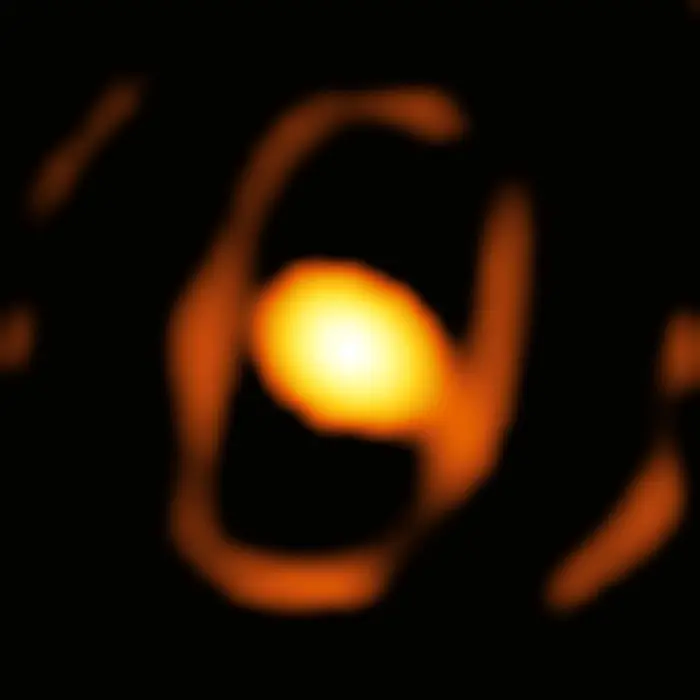
This is an image of the star WOH G64, taken by the GRAVITY instrument on the European Southern Observatory’s Very Large Telescope Interferometer (ESO’s VLTI). This is the first close-up picture of a star outside our own galaxy, the Milky Way. The star is located in the Large Magellanic Cloud, over 160 000 light-years away. The bright oval at the centre of this image is a dusty cocoon that enshrouds the star. A fainter elliptical ring around it could be the inner rim of a dusty torus, but more observations are needed to confirm this feature. Image credit: ESO/K. Ohnaka et al. (CC BY 4.0)
Name
WOH G64 does not have a proper name. The “WOH” in WOH G64 is taken from the initials of the three astronomers who discovered the star: Westerlund, Olander and Hedin. It is used for an entire catalogue of supergiant and giant stars in the Large Magellanic Cloud.
Location
WOH G64 is located in the Large Magellanic Cloud (LMC), a satellite galaxy of the Milky Way and the fourth largest galaxy in the Local Group, after Andromeda (M31), the Milky Way, and the Triangulum Galaxy (M33).
Lying at a distance of about 163,000 light years, the LMC is the second or third nearest galaxy to our own. It is classified as a Magellanic spiral galaxy, a dwarf galaxy with a single spiral arm. With an apparent magnitude of 0.9, the galaxy appears as a hazy cloud on a clear night, but due to its southern location, it is invisible to most northern observers. It can only be seen from locations south of the latitude 20° N.
At declination -68°, WOH G64 never rises above the horizon north of the northern tropical latitudes. The star is much too faint to be visible in amateur telescopes.
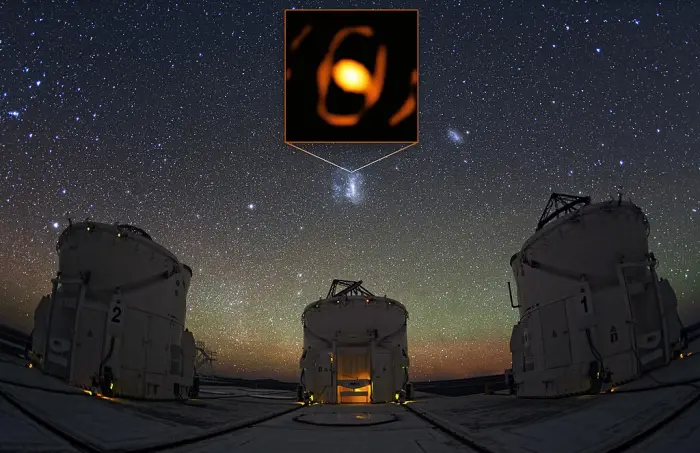
The Large Magellanic Cloud is a satellite galaxy to the Milky Way, located 160 000 light-years away from us. Despite the staggering distance, the GRAVITY instrument of the European Southern Observatory’s Very Large Telescope Interferometer (ESO’s VLTI), managed to take a closed-up picture of the giant star WOH G64. This image shows the location of the star within the Large Magellanic Cloud, with with some of the VLTI’s Auxiliary Telescopes in the foreground. Image credit: ESO/K. Ohnaka et al./Y. Beletsky (LCO) (CC BY 4.0)
Constellation
WOH G64 is located in the constellation Dorado, the Dolphinfish. Dorado is not one of the ancient constellations. It was created by the Dutch-Flemish astronomer Petrus Plancius in the 16th century based on observations of Dutch navigators who had travelled to the southern hemisphere.
Dorado is the 72nd largest of the 88 constellations. It stretches across only 179 square degrees of the southern sky between the bright Achernar in Eridanus and Canopus in Carina.
Even though it is one of the fainter constellations, Dorado contains a number of interesting stars and deep sky objects. Alpha Doradus, the constellation’s brightest star, is a white giant that shines at magnitude 3.27 from a distance of around 169 light-years.
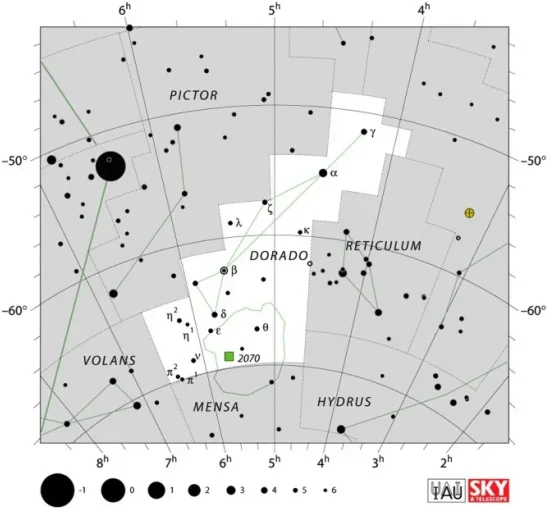
Dorado constellation map by IAU and Sky&Telescope magazine (Roger Sinnott & Rick Fienberg) (CC BY 3.0)
Other notable stars in Dorado include the luminous blue variable S Doradus, the red giant Mira variable R Doradus, and the pulsating variable Gamma Doradus, the prototype for its own class of variable stars. Dorado also hosts the Wolf-Rayet stars BAT99-98, possibly the most massive star known, and R136a1, one of the most massive and luminous stars discovered to date.
The best-known deep sky object in Dorado is the Large Magellanic Cloud (LMC), a Milky Way satellite that contains a number of notable features. These include the star-forming regions known as the Tarantula Nebula (NGC 2070) and the Ghost Head Nebula (NGC 2080) and the star cluster R136. R136 at the centre of the Tarantula Nebula is home to some of the most massive and luminous stars discovered to date, including R136a1, R136a7, and R136c.
Dorado also hosts the Dorado Group of galaxies, whose brightest members include the intermediate spiral galaxy NGC 1566 (the Spanish Dancer), and the interacting galaxies NGC 1549 and NGC 1553.
The best time of the year to observe the stars and deep sky objects in Dorado is during the month of January, when the constellation appears higher above the horizon in the early evening. The entire constellation is visible from locations between the latitudes 20° N and 90° S.
The 10 brightest stars in Dorado are Alpha Doradus (mag. 3.27), Beta Doradus (mag. 3.46 – 4-08), Gamma Doradus (mag. 4.25), Delta Doradus (mag. 4.34), HD 40409 (mag. 4.65), Zeta Doradus (mag. 4.82), Theta Doradus (mag. 4.82), Eta2 Doradus (mag. 5.01), Nu Doradus (mag. 5.06), and Epsilon Doradus (mag. 5.11).
WOH G64
| Spectral class | (M7.5(I)e) + B |
| Variable type | Slow irregular variable, symbiotic binary |
| Apparent magnitude (V) | 18.46 (17.7 – 18.8) |
| Apparent magnitude (K) | 6.849 |
| Apparent magnitude (R) | 15.69 |
| Apparent magnitude (G) | 15.0971 |
| Apparent magnitude (I) | 12.795 |
| Apparent magnitude (J) | 9.252 |
| Apparent magnitude (H) | 7.745 |
| Absolute magnitude | -6.00 |
| Distance | 160,000 light years (50,000 parsecs) |
| Parallax | -0.2477 ± 0.0430 mas (Gaia DR3) |
| Radial velocity | 285 ± 2 km/s |
| Proper motion | RA: 1.689 ± 0.054 mas/yr |
| Dec.: -0.013 ± 0.057 mas/yr | |
| Mass (initial) | 25 ± 5 M☉; 28 M☉ |
| Luminosity | 280,000 – 490,000 L☉ |
| Radius | ~800 R☉ |
| Temperature | 4,700 K |
| Surface gravity | 0.0 cgs |
| Age | ≤5 million years |
| Constellation | Dorado |
| Right ascension | 04h 55m 10.5236094912s |
| Declination | −68° 20′ 30.019011036″ |
| Designations | WOH G64, IRAS 04553-6825, LI-LMC 181, MSX LMC 1182, DCMC J045510.49-682030.2, MACHO 47.2368.9, OGLE LMC-LPV-6819, TIC 30186593, WISE J045510.51-682030.2, 2MASS J04551048-6820298, 2MASSI J0455105-682029, Gaia DR2 4661527262798576768, Gaia DR3 4661527262798576768 |